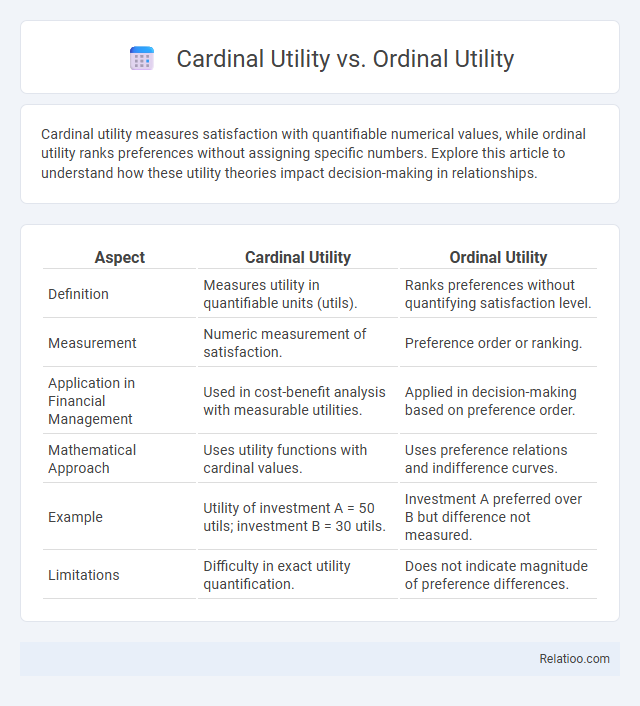Cardinal utility measures satisfaction with quantifiable numerical values, while ordinal utility ranks preferences without assigning specific numbers. Explore this article to understand how these utility theories impact decision-making in relationships.
Table of Comparison
| Aspect | Cardinal Utility | Ordinal Utility |
|---|---|---|
| Definition | Measures utility in quantifiable units (utils). | Ranks preferences without quantifying satisfaction level. |
| Measurement | Numeric measurement of satisfaction. | Preference order or ranking. |
| Application in Financial Management | Used in cost-benefit analysis with measurable utilities. | Applied in decision-making based on preference order. |
| Mathematical Approach | Uses utility functions with cardinal values. | Uses preference relations and indifference curves. |
| Example | Utility of investment A = 50 utils; investment B = 30 utils. | Investment A preferred over B but difference not measured. |
| Limitations | Difficulty in exact utility quantification. | Does not indicate magnitude of preference differences. |
Introduction to Utility Theory
Utility theory evaluates consumer preferences to explain decision-making and satisfaction levels. Cardinal utility assigns numerical values reflecting the magnitude of satisfaction, while ordinal utility ranks preferences without quantifying intensity. Your understanding of utility enhances insights into economic behavior and choice optimization.
Defining Cardinal Utility
Cardinal utility quantifies satisfaction with measurable units, allowing precise comparisons and calculations of consumer preferences, unlike ordinal utility which only ranks choices without indicating magnitude. Your decision-making improves as cardinal utility enables analyzing not just the order but also the intensity of preferences. Utility, in general, represents the satisfaction derived from goods or services, but cardinal utility specifically provides a numerical value to that satisfaction.
Defining Ordinal Utility
Ordinal utility refers to a way of ranking preferences without assigning specific numerical values to satisfaction, emphasizing the order of choices rather than their magnitude. Unlike cardinal utility, which quantifies exact levels of happiness or utility, ordinal utility only requires that You can determine which options are preferred or indifferent. This concept is foundational in consumer theory because it enables analysis of decision-making based on preference ordering without assuming measurable satisfaction scales.
Key Differences Between Cardinal and Ordinal Utility
Cardinal utility measures satisfaction with quantifiable units, allowing You to compare the magnitude of preferences numerically, while ordinal utility ranks preferences without assigning specific values, focusing on order rather than intensity. The key difference lies in cardinal utility's ability to express how much more one option is preferred over another, whereas ordinal utility only indicates which option is preferred without quantifying the difference. Utility, in general, represents the satisfaction or benefit derived from goods or services, but cardinal and ordinal utilities differ fundamentally in measurement and interpretability.
Measurement Methods in Utility Analysis
Cardinal utility measures satisfaction through quantifiable units, allowing precise comparisons of utility differences, while ordinal utility ranks preferences without specifying the magnitude of differences. Utility analysis using cardinal measurement employs numerical scales or utility functions to capture intensity of preferences, whereas ordinal measurement relies on preference orderings or choice data to establish rankings. Your understanding of these methods enhances decision-making by clarifying how utility is measured and interpreted in economic and behavioral contexts.
Real-World Applications of Cardinal Utility
Cardinal utility quantifies satisfaction with measurable units, enabling precise consumer choice modeling and demand forecasting in real-world economic scenarios. Unlike ordinal utility, which ranks preferences without specifying intensity, cardinal utility supports cost-benefit analysis and utility maximization strategies crucial for businesses and policymakers. Your decision-making benefits from understanding cardinal utility's role in pricing strategies, resource allocation, and welfare economics.
Real-World Applications of Ordinal Utility
Ordinal utility, which ranks preferences without assigning specific numerical values, is widely applied in consumer choice theory to model decision-making under uncertainty and budget constraints. Real-world applications include market research for understanding consumer preferences, designing auction mechanisms, and public policy analysis where preference rankings guide resource allocation without requiring exact utility measurements. This approach provides practical insights in fields like behavioral economics and welfare economics by capturing relative satisfaction rather than precise utility quantification.
Advantages and Limitations of Cardinal Utility
Cardinal Utility measures satisfaction using numerical values, allowing for quantifiable comparisons of utility and the calculation of total and marginal utility, which facilitates precise analysis of consumer choice and demand elasticity. Its main advantage lies in enabling measurable utility differences, aiding in welfare economics and cost-benefit analysis. Limitations include its unrealistic assumption that utility can be objectively quantified and compared, which ignores subjective preferences and interpersonal utility comparisons.
Advantages and Limitations of Ordinal Utility
Ordinal utility provides a practical approach to preference ranking by focusing on the order of choices without requiring precise numerical values, making it easier to apply in real-world decision-making scenarios. Its main advantage lies in capturing consumer preferences through simple comparisons, enhancing the flexibility of utility analysis when measuring satisfaction is difficult or subjective. However, ordinal utility is limited by its inability to measure the intensity of preferences, preventing quantification of how much more one option is favored over another, unlike cardinal utility which assigns specific utility values reflecting preference strength.
Implications for Consumer Behavior and Economic Policy
Cardinal utility quantifies satisfaction with measurable units, enabling precise calculations of consumer surplus and demand elasticity, which guide targeted economic policies such as taxation and subsidies. Ordinal utility ranks preferences without measuring exact satisfaction levels, influencing consumer choice theory and policy design focused on preference order rather than intensity. Understanding these distinctions helps Your business or economic strategy optimize resource allocation and tailor interventions based on consumer behavior patterns.

Infographic: Cardinal Utility vs Ordinal Utility
 relatioo.com
relatioo.com